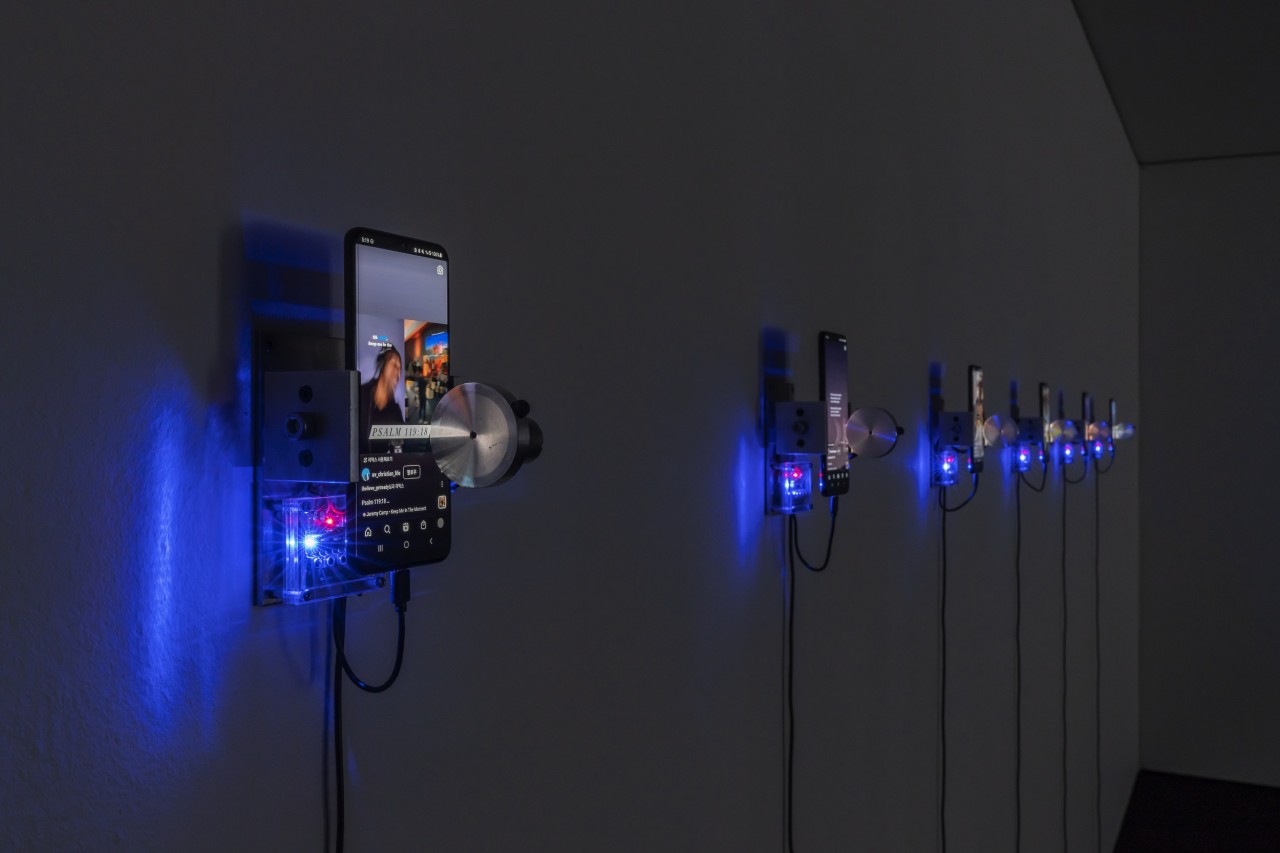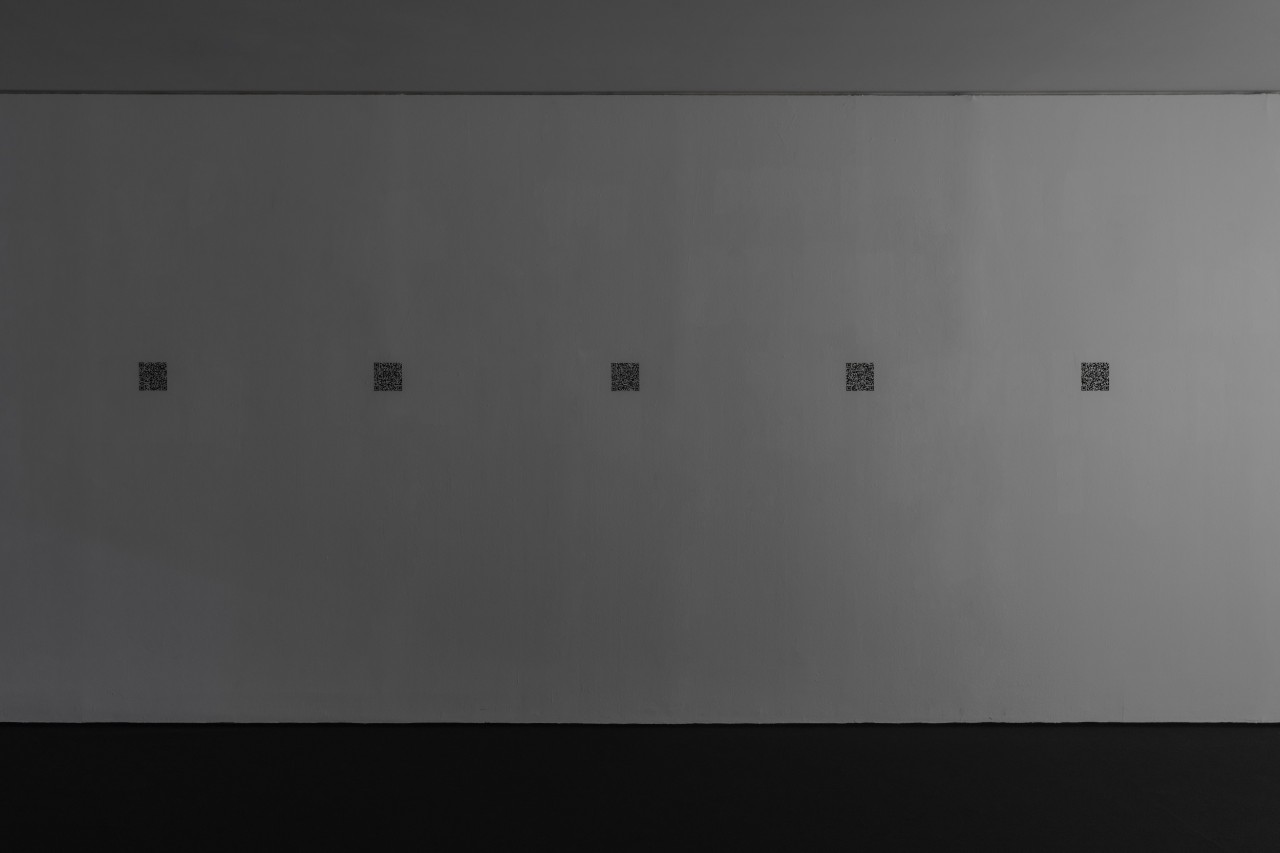Exhibitions
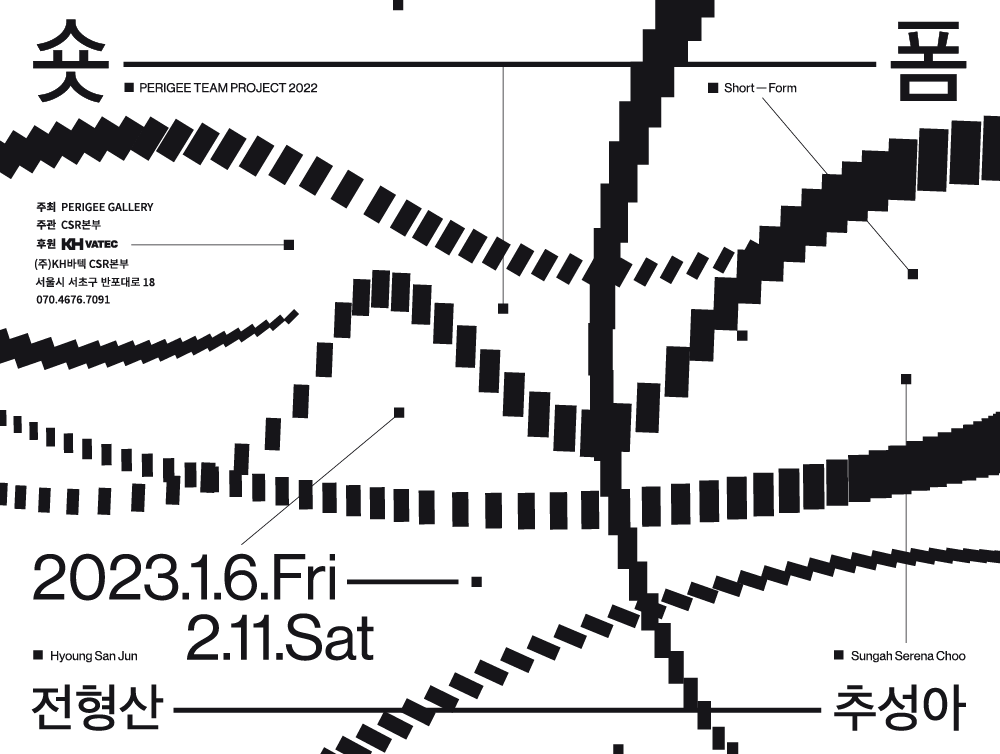
PERIGEE TEAM PROJECT 2022
숏—폼 Short—Form
2023.01.06. FRI ~
2023.02.11. SAT
<곧, 휘발될 현재, 다가올 과거, 누적될 미래>
추성아
전시 《숏—폼(Short—Form)》의 출발은 포스트-펜데믹 이후 등장하기 시작한 비물질화된 전시 형식에 대한 고민에서 비롯되었다. 예컨대, QR 코드는 전시에 가장 많이 침투한 매개체로 신체와 가상 공간, 그리고 물리적 공간의 경계가 모호해면서 디지털 기술이 보다 용이한 형식으로 일상에 투입되었고, 창작자와 관객은 대상과 이미지를 경계없이 인식하게 되는 전환점을 맞이하였다. 여기서 전시는 비물질 매개 코드가 담보하고 있는 자기생산적 행위를 스스로 제공하고, 공유하고, 흡수하고, 수용해버린 신체의 연장이자 일부가 되어버린 기술적인 지점을 고려하게 된다. 많은 것들이 물리적으로 단축된 과정에서 우리가 쉽게 놓칠 법한 감각은, 시간성 위에 흩어져 화각에 들어오지 않는 다크 필드(Dark Field)와 분명하게 먼저 인식되는 브라이트 필드(Bright Field)의 영역¹처럼 전시장에서 관객 주변을 통과한다. 이때, 신체와 거리를 두는 반면에 신체를 배제하고 대상을 인식할 수 없듯이, 시간을 점유하고 있는 기초적인 요소를 모색한다면 오늘날의 가장 사적이면서 공적인 비물질의 공간 위에 우리의 일상과 혼재된 요소들을 염두하는 것에서부터 시작할 수 있다.
2022 페리지 팀프로젝트는 스스로의 감각을 의심하는 것에서 출발하여 노이즈라는 소리 객체의 구조화를 통해 “들려주기 위한 행위”와 “듣게 만들기”를 ....
The Present to be Volatilized, the Past to Come, the Future to Accumulate, Soon
Sungah Serena Choo
The exhibition Short—Form began with a reflection on the dematerialized exhibition format that started emerging in the post-pandemic situation. For example, QR codes are the medium that has penetrated the most into exhibitions. As the boundaries between the body, virtual space, and physical space have become blurred, digital technology has been introduced into daily life in a more convenient format. Creators and audiences have reached a turning point in recognizing objects and images without boundaries. At this point, exhibitions consider the technological concerns at which the self-productive acts of immaterial and intermediary codes have become an extension and part of the body that has provided, shared, absorbed, and accommodated itself. In the process where many things have become physically reduced, there are certain senses that we might easily miss. These senses pass through the periphery of the audience in the exhibition space like the ‘dark field,’ which is scattered over temporality and does not enter t....
추성아
전시 《숏—폼(Short—Form)》의 출발은 포스트-펜데믹 이후 등장하기 시작한 비물질화된 전시 형식에 대한 고민에서 비롯되었다. 예컨대, QR 코드는 전시에 가장 많이 침투한 매개체로 신체와 가상 공간, 그리고 물리적 공간의 경계가 모호해면서 디지털 기술이 보다 용이한 형식으로 일상에 투입되었고, 창작자와 관객은 대상과 이미지를 경계없이 인식하게 되는 전환점을 맞이하였다. 여기서 전시는 비물질 매개 코드가 담보하고 있는 자기생산적 행위를 스스로 제공하고, 공유하고, 흡수하고, 수용해버린 신체의 연장이자 일부가 되어버린 기술적인 지점을 고려하게 된다. 많은 것들이 물리적으로 단축된 과정에서 우리가 쉽게 놓칠 법한 감각은, 시간성 위에 흩어져 화각에 들어오지 않는 다크 필드(Dark Field)와 분명하게 먼저 인식되는 브라이트 필드(Bright Field)의 영역¹처럼 전시장에서 관객 주변을 통과한다. 이때, 신체와 거리를 두는 반면에 신체를 배제하고 대상을 인식할 수 없듯이, 시간을 점유하고 있는 기초적인 요소를 모색한다면 오늘날의 가장 사적이면서 공적인 비물질의 공간 위에 우리의 일상과 혼재된 요소들을 염두하는 것에서부터 시작할 수 있다.
2022 페리지 팀프로젝트는 스스로의 감각을 의심하는 것에서 출발하여 노이즈라는 소리 객체의 구조화를 통해 “들려주기 위한 행위”와 “듣게 만들기”를 작업의 주요 맥락으로 가져왔던 작가 전형산의 작업을 기획자 추성아와 함께 유사 맥락 위에 다른 형식으로 발전시켜 보여주는데 주목한다. 전형산은 심리적, 역사적 맥락을 빌어와 개인의 관습적 혹은 사회적 관계에서 비롯된 소통의 문제를 물리적인 형태와 구조로 대상화해왔다. 이번 전시에서 전형산과 추성아의 협업은 물리적인 구조체를 덜어내고, 가장 동시대적인 사운드 소스를 주요 참조점으로 삼아, 구조적으로 분산되고 소리의 ‘형식’이 전환되는 역할을 극대화 하고자 한다. 기획자와 작가가 기준점을 삼았던 것은 노이즈라는 ‘비음악적 소리’의 생산과 구조에 의해 형성되는 관계 속에서 가장 동시대적인 미디어에 소리와 이미지가 전복되는 감각을 드러내고자 하는데 있다. 무엇보다, 본 전시에서는 사물 내부에 복수의 객체를 포함하고 있는 비물질의 영역에서 앞서 언급한 다크와 브라이트 필드의 장소들이 끝없이 활성화되고 있는 것을 뒷받침하는 사운드에 주목한다.
다크 필드: 이미지 밖 사운드
전시 《숏—폼》은 사운드라는 재료가 사회적, 문화적 기제로서 새로운 기호체계로 변이되면서 완결된 형태로 인식되기보다, 부산물이 되어 버린 소리 찌꺼기(sound crap)의 매체적 속성에 주목한다. 반면에, 다루고자 하는 부산물의 소리조차 어떤 형태의 공간성이 뒷받침 될 수 밖에 없는 결론에 도달하게 된다. 전시는 이미지와 소리가 공존적 동반자임을 전제하고, 무작위로 넘어가는 인스타그램 릴즈(Reels) 화면이 여섯 개의 스마트폰에서 실시간으로 재생되도록 한다. 각각의 스마트폰에서 동시에 뒤섞이는 소리는 거대한 백색 간판 구조물로 송출되어 깜빡 거리는 빛의 움직임과 연동(Darkfield, 2022)된다. 이처럼, 《숏—폼》에서는 동시대가 시각중심주의 혹은 청각중심주의라는 고정적인 생각에서 벗어나 이미지와 소리가 상호 교차하고 있는 문화현상의 일부를 전시의 소재로 소환했다. 여기서 이미지와 소리의 교차 현상은 시간성과 공간성과 관계된다. 현대인이 가장 많이 사용하고 있는 소셜 네트워크 플랫폼인 인스타그램의 릴즈가 이 두 가지를 교차하고 있다는 점에서 릴즈를 전시장으로 끌어와 이미지의 청각화와 소리의 시각화 과정에서 ‘이용자’이자 ‘소비자’인 우리에게 사각지대였던 ‘소리’를 극대화 하기로 한다. 이용자들이 릴즈를 다루고 있는 여러 방식에서의 공통점은 이미지와 소리가 각각의 단일 매체로서 가지고 있는 표현의 한계를 서로 보완한다는 점이다. 특히, 페이스북, 인스타그램에서 게시물을 게시하는 개념은 소리보다 프레임 안에 고정된 이미지와 텍스트에 무게를 뒀었다면, 점차 최대 1분 길이의 영상 이미지와 소리가 동반되어 릴즈 컨텐츠를 소비하도록 주력하고 있는 것을 볼 수 있다.
이렇듯, 형식이 부각된 컨텐츠 용어 ‘숏 폼(Short Form)’은 편집된 실시간 영상이 소리를 시각화 하는 지점과 연동될 수 밖에 없는 인스타그램 릴즈 특성을 전시 제목의 전면에 두게 되었다. '숏 폼'은 영상에서 사용되는 용어로 이미지와 영상의 짧은 호흡으로 소비되는 것과 연관된다. 해당 용어의 길이와 속도감이 연상되는 형식에 주목하는 이번 전시는 SNS에서 소비되는 이미지보다 부산물로 함께 묶이기 시작한 소리에 주목하게 된다. 이로써, 시각적 이미지가 앞서면서 일회적 속성을 지닌 릴즈의 사운드가 휘발되는 소리의 위치에 대한 질문을 해 볼 수 있다. 나아가, 온라인 플랫폼이라는 비물질 공간에 유저들의 생산과 소비가 가장 활발하게 일어나면서, 개인의 기호에 맞는 영상을 자동으로 제공해주는 인공지능 기능이 탑재되어 매우 짧은 길이의 형식 위에 압축 및 편집된 경험과 기억을 송출한다. 결국, 물리적인 공간에 경험과 가치, 그리고 기억을 더하면 비로소 개념적인 장소가 되고, 경험적 데이터가 축적되어야 장소가 되듯이, 우리가 장소를 갈망하는² 개인의 욕망이 압축된 매우 빠른 속도에 도달하는 이미지와 사운드가 끝없이 갱신되는 것을 보여준다. 한편으로, 인스타그램에서 공간을 제어하는 방식은 각기 다를 수 밖에 없는데, 어떤 이들에게는 공간을 조직하고 통제할 필요가 없기도 한다. 그러나 인스타그램이라는 비물질 장소에서 게시되는 이용자의 포스트는 그 어느때 보다 장소애를 드러내면서 개인의 삶의 경험과 감정을 필사적으로 박제하려는 심리의 집합체라 할 수 있다. 이때 사운드는 화각에 잡히지 않는 다크 필드처럼 사각지대에서 욕망을 소리없이 점화한다.
데이터 매시업: 뭉개진 시퀀스
《숏—폼》은 전시장에서 무작위로 재생되는 릴즈 무빙 이미지가 보여주는 실시간성과 정지되지 않는 루프에 주목한다. 검색 기준 혹은 특정 카테고리의 영상을 습관적으로 보다 보면, AI가 여기에 맞춰 자동으로 유사한 영상을 띄워주듯이, 전시에서 우연을 가장한 예측된 구조에 기대어 본다. 여섯 개의 스마트폰에 재생되는 동일한 계정에서 이용자들이 보편적으로 가장 많이 보는 무작위의 영상들이 각기 다른 시간차로 넘어간다. 어떤 영상은 재연 장면이 허구를 동원해서라도 드라마틱하게 왜곡된 경험과 기억을 발화하고자 하는 이미지면서도 대부분 시각적 잉여로 남는다. 각각의 슬롯이 넘어가면서 뒤섞이는 이미지는 우리가 이동중에 혹은 자기 전에 누워서, 또는, 휴식을 취할 때 멍하니 보는 넘쳐나는 이미지가 무음 상태에서 움직이는 이미지로 먼저 인식될 확률이 높다. 이때 사운드는 숱한 데이터들 사이에서 발췌되어 나름의 원칙에 따라 편집을 하면서 주석으로의 위치를 갖게 된다. 이를 바탕으로, 전시에서는 문자적으로 ‘숏 폼’의 형식 위에 완벽하게 작동하는 뒤범벅 된 사운드를 움직이는 거대한 빛을 담고 있는 백색 간판의 물리적인 대상에 대입하여 앞세우는데 주력하게 된다. 또한, 작은 스마트폰 화면 위에 넘어가는 릴즈보다 송출되는 사운드의 리듬, 멜로디, 타격감에 맞춰 스피커에서 발산되는 빛의 움직임과 소리를 가장 먼저 감지하도록 한다. 이로써, 전시는 이미지 중심이었던 구조에서 고유의 목적을 지닌 이미지이기보다 사운드를 보조하기 위해 덧댄 비주얼로 전복되는 것을 목표로 한다.
2미터 남짓한 거대한 수직 수평의 백색 간판을 스피커로 개조한 사물-대상(Darkfield, 2022)은 마치, 망가진 혹은 비활성화된 시스템처럼 스마트폰에서 송출하는 소리 찌꺼기들을 수용한다. 소리의 발신과 수신체의 이동을 육안으로 이해하기 위해 송출과 청취, 여기에 더해 관객이 참여하여 소리를 다양한 스펙의 이펙터로 믹싱할 수 있도록 제안하기로 한다. 이 과정을 강조했던 것은, 미디어 기능이 소비된 후에 남겨진 부산물(잔여물)에 주목하기 위해 소리의 흐름을 형식 자체로써 물리적으로 감지할 수 있도록 가장 단순하게 접근했다. 즉, 동시대에 소리가 어느 위치에 있었는지, 그리고 사운드 아트가 유사 ‘준대상(quasi-object)’³으로 작동해왔던 방식을 뒤섞인 층위의 감각으로 전달하고자 한다. 이는 스마트폰의 스크린과 소비되는 기술에서 지나간 시간만을 볼 것이 아니라, 오작동하는 듯한 내부를 들여다 보는 중첩된 로우-파이(Lo-fi) 소리에 귀 기울이기를 요청한다. 관객에게 직접 믹싱을 하도록 유도하는 태도는, 디지털의 본질적 속성을 갖고 있는 리믹스가 릴즈의 이미지와 소리가 리믹싱 되어 나오는 컨텐츠의 속성을 흡수하기 위해서다. 우리가 디지털 문화의 네트워크 와이어, 선, 라우터, 스위치처럼 버려질 물질적인 것들의 더미에서 벗어날 수 없는 것이라면, 어플리케이션의 미디어 레이어에 사운드가 기기의 부산물에 의해 매개됨으로써, 소비와 참조의 맥락 위에 시각적 결과물을 발생시키려는 것이라는 점에 주목한다.
결국 데이터 매시업의 다양한 형식은 전시에서 원본성에 대한 질문들이 믹스되어 파편적으로 뒤섞인다. 글쓰기의 대안으로 인공지능에 의해 예측되는 형식을 QR 코드로 인식하는 각각의 항목에 활용하는 것이 그 중 하나다. 일부분 딥러닝 모델인 OpenAI.com에서 복잡한 것에 대한 순발력과 창의력에 뛰어난 text-davinci-003 모델과 사운드와 릴즈에 대한 가장 기본적인 대화와 단편적인 글쓰기 지시, 그리고 기초 질문을 던지는 방식을 글쓰기에 활용했다.⁴텍스트의 의미를 파악하고 그 성격을 추론해야 하는 과업을 해결하는 것에 가까우나 아직은 조금 단편적인 이 모델을 활용한 것은, 릴즈에서 작동하는 인공지능의 자동 완성 속성과 컴퓨터에서 시퀀스로 표현될 수 있는 코드와 이미지, 사운드에 적용되고 있는 모델들을 하나의 협업자로 인식한데서 기인한다. 비록, 텍스트가 어느 순간 다른 질문에서 동일한 대답이 반복적으로 나오거나 맥락에서 벗어나는 소재가 뜬금없이 대답 안에 개입되는 등 기술적으로 미흡한 부분이 있지만, 흥미롭게도 오작동하는 결과물을 그대로 드러나는 것이 데이터 매시업의 태도와 연동되며 종합적으로 뒤섞인 소리를 뒷받침하는 역할을 한다. 동시에, AI의 텍스트가 보편적이고 매우 단순한 내용일지라도 깊은 곳 어딘가를 찌르는 철학적인 사유의 태도가 은연중에 드러나 묘하게 설득력 있으면서 다양한 캐릭터를 구사한다는 것이다. 텍스트는 소리가 릴즈에서 어떤 역할을 하고 정의되는지, 전시에서 고민했던 키워드들을 파편적으로 던져 놓으면 이를 정리하거나, 가상의 짧은 문단의 에세이를 쓰도록 지시하는 등 이 또한 분절되고 뭉개진 시퀀스처럼 전시에서 작동하는데 있다.
전시 《숏—폼》 전반은 온라인 어플리케이션 안에 게시된 유저들의 다양한 장소적, 행위적, 대상 등의 소재에 기인한 이미지와 사운드, 빛, 그리고 여기서 파생된 파편적인 텍스트들의 믹싱으로 구성된다. 전시장에서 각각의 매체들이 송수신의 방향에 맞춰 뒤섞이면서 우리는 이들이 모두 명백한 부산물임을 다시 확인하게 된다. 시간성이 가장 의미가 큰 사운드가 기록의 의미와 완결된 형태의 고정된 특성에서 벗어나지만, 전시에서는 이를 거대한 오브제를 강제로 통과하게 하면서 소리들이 더욱 압축적으로 섞이도록 유도한다. 이 때, 전시의 중심축이 되는 참조점인 인스타그램에서 작동하고 있는 ‘숏 폼’의 매우 짧은 생산 및 소비 호흡이 시간의 지배를 받으면서도 그에 벗어나는 양가적인 속성을 갖게 된다. 사운드의 경우 시간의 제약을 벗어날 때서야 비로소 완결성이라는 결과를 믹싱을 통해 얻을 수 있듯이, 전시에서 사운드 찌꺼기이자 소음으로 변환시키므로 소음 그 자체로 완결된 것을 인정하도록 제시한다. 사운드 표현의 극대화에 목적을 둔 《숏—폼》에서는 ‘믹싱’이 여러 참조점들을 바탕으로 가상의 표현 영역을 청각적 현실성으로 전환하는 동시에, 사운드를 시각적으로 왜곡, 확장하여 공간 안에서 텍스트와 함께 가상의 표현 영역이 확보되는 뒤바뀐 현상의 주범이 된다. 그리하여 과거와 현재, 미래시제의 시간들이 각각의 계정과 관객들 사이에서 휘발되고, 누적되고, 거꾸로 간다.
_________________________________________
¹ 다크 필드와 브라이트 필드는 카메라 렌즈의 화각에 이미지가 들어오지 않는 영역과 그와 반대로, 이미지가 반사되어 올라오는 영역을 지칭한다.
² 지리학자 이-푸 투안(Yi-fu Tuan, 1930-2022)의 저서 『공간과 장소』(사이, 2020) 참조.
³ 해당 용어는 브뤼노 라투르(Bruno Latour)가 언급했던 단어로, 비물질 행위자 네트워크를 주제로 비인간과 포스트휴머니즘에서 사용된다. ‘준대상들(quasi-objects)’은 시간 안에 어떠한 흔적을 남기고 사라지는 현재가 부재하는, 그러나 미래 시간의 상호작용적 전이 공간, 혹은 끊임없이 변환되고 있는 공간을 이루므로, 대상들이 현상학적 대상성을 갖는 것을 말한다.
⁴www.openai.com에서 text-davinici-003 모델 사용.
Sungah Serena Choo
The exhibition Short—Form began with a reflection on the dematerialized exhibition format that started emerging in the post-pandemic situation. For example, QR codes are the medium that has penetrated the most into exhibitions. As the boundaries between the body, virtual space, and physical space have become blurred, digital technology has been introduced into daily life in a more convenient format. Creators and audiences have reached a turning point in recognizing objects and images without boundaries. At this point, exhibitions consider the technological concerns at which the self-productive acts of immaterial and intermediary codes have become an extension and part of the body that has provided, shared, absorbed, and accommodated itself. In the process where many things have become physically reduced, there are certain senses that we might easily miss. These senses pass through the periphery of the audience in the exhibition space like the ‘dark field,’ which is scattered over temporality and does not enter the angle of view, and the ‘bright field,’ which is clearly recognized before anything else.¹ Just as we cannot perceive objects without the body while distancing ourselves from it, we can begin from considering the elements interwoven with our daily lives on top of today’s most private and immaterial public spaces when we search for the basic elements that occupy time.
The Perigee Team Project 2022 focuses on developing the work of artist Hyoung San Jung into another format in a similar context to curator Serena Sungah Choo. Jung has been staging “the act for making people listen” and “making people listen” as the key context of his work through the structuring of noise as a sound object. Jun has objectified communication problems arising from the customary relationship between individuals or social relations in physical form and structure, borrowing psychological and historical contexts. In the current exhibition, the collaboration between Hyoung San Jun and Serena Sungah Choo aims to reduce the physical structure and maximize the structural dispersion and transition of the ‘form’ of sound, taking the most contemporary sound sources as the main reference points. These reference points of the curator and the artist are employed in order to reveal the sense of subversion of sound and image in the most contemporary media within the relationship formed by the production and structure of noise as “non-musical sound.” Above all, the exhibition focuses on the sound that underpins the endless activation of the places within the aforementioned dark and bright fields in the immaterial realm that contains a plurality of objects within objects.
Dark Field: Sound Outside Image
The exhibition Short—Form focuses on the medium properties of ‘sound crap,’ which has become a by-product instead of a finished form as the material of sound has been transformed into a new system of signs as a social and cultural mechanism. In the meantime, the exhibition comes to a conclusion that even sound as a by-product necessarily needs some form of spatiality as its support. The exhibition presupposes that images and sounds are coexisting companions. As such, six smartphones are installed in the exhibition with randomly shuffling Instagram Reels on the screen. The simultaneous shuffling sound from each smartphone is transmitted to a huge white signage structure. It is then synchronized with the movement of flickering light. In such a way, Short—Form moves away from the fixed ideas of visual-centrism and audio-centrism in our time and summons a part of the cultural phenomena in which images and sounds intersect as its subject. At this point, the intersectionality of image and sound establishes a relationship with temporality and spatiality. From the fact that the Reels on Instagram, which is the most widely used social network platform, also intersects images and sounds, the exhibition incorporates Reels into the exhibition space. By doing so, it maximizes ‘sound,’ which has been a blind spot for us as ‘users’ and ‘consumers,’ in the process of sonifying images and visualizing sounds. What users have in common in the various ways they use Reels is that images and sounds complement each other’s expressive limitations as a singular medium. In particular, while posts on Facebook and Instagram have been based on images fixed within the frame and accompanied texts, they now gradually herald the users to consume contents on Reels that provide video images and sounds up to one minute.
In this sense, the exhibition foregrounds ‘short form,’ a term in the content industry that cannot but be linked to the points where the edited real-time videos visualize sounds, as its title. ‘Short form’ is also a term used in video and is associated with the consumption of images in videos in short duration. Focusing on the very format that is associated with the length and speed of the term ‘short form,’ the exhibition turns away from images consumed on social network services and attends to sounds that are associated with the images as their by-products. As a result, the exhibition enables certain questions on the volatilization of sounds of the Reels, which emphasize visual images with a one-off nature. Furthermore, as users most actively produce and consume in the immaterial space of online platform, artificial intelligence automatically provides video images that match individual preferences. It transmits compressed and edited experiences and memories in a format with a very short duration. After all, the addition of experience, value, and memory to physical space makes it a conceptual place. The accumulation of experiential data makes a space into a place. It shows an endless renewal of images and sounds that reach a very fast pace at which individual desires for places² are compressed. On the other hand, the way we control spaces on Instagram is bound to be different for each individual since there are certain people who do not need to organize and control them. However, the posts on Instagram are nothing but a collection of psychology that desperately tries to capture an individual’s life experiences and emotions revealing a ‘sense of place.’ Here, the sound silently ignites a desire in the blind spot, just like a dark field that is not captured within the angle of view.
Data Mashup: Crushed Sequences
Short—Form draws attention to the real-time and non-stop loop of the moving images on Reels playing randomly in the exhibition. It depends on a seemingly predicted structure masquerading as a coincidence, just as AI automatically displays similar videos when one habitually watches certain videos based on a particular search criterion or category. The six smartphones in the exhibition space run on the same Instagram account, but they display randomly played popular videos by a different set of timings. Some of the videos are reenactments that attempt to speak about dramatically distorted experiences and memories even through the use of fiction. However, most of them remain as visual surpluses. The images shuffled by the passing of different slots are likely to be perceived as silently moving images since they are the overflowing images that we numbly gaze upon while we are on the move, lying down before falling asleep, or taking rest. At this time, the sound is extracted from a plethora of data and edited according to its own principles, taking its place as an annotation. Based on this realization, the exhibition invests in substituting a perfectly functioning jumble of sounds on the basis of the ‘short form’ format against the physical object, which is white signage that contains a huge light on the move. In addition, the signage detects the movement and sound of light from the speaker in accordance with the rhythm, melody, and feeling of the sound instead of the Reels passing over the small smartphone screens. In this way, the exhibition aims to subvert the image with its own purpose within an image-centered structure into an added visual that supports sound.
The thing-object (Darkfield, 2022), which is a vertical and horizontal white signage about two meters tall turned into a speaker, accommodates the sound debris emitted by smartphones as if it was a broken or deactivated system. In order to offer a visual understanding of the transmission and movement of sound, it materializes the delivery and listening of sound. In addition, it proposes the audience to mix the sound with a variety of effectors. The emphasis on this process is the simplest way to enable a physical approach toward the flow of sound to focus on the by-products (residues) that remain after the media function of sound is consumed. In other words, the exhibition seeks to convey where sound has been residing in our time and how sound art has been operating as a ‘quasi-object’³ with a mixed sense of layers. It asks us not only to look at the time that has passed on the smartphone screens and technology being consumed, but also to listen to the layered lo-fi sound that looks into its seemingly malfunctioning inside. The attitude of encouraging the audience to mix the sound by themselves intends to set the remix, which bears the intrinsic properties of digital, to absorb the properties of contents on Reels where images and sounds are remixed. If we assume that we cannot escape the pile of things to be discarded, such as network wires, cables, routers, and switches, it yields an emphasis on the fact that the mediation of sound through the by-products of devices on the media layer of applications aims to generate visual results in the context of consumption and reference.
Ultimately, the various forms of the data mashup are fragmented with questions about originality in the exhibition. One such form is the use of QR codes to point to the forms predicted by artificial intelligence as an alternative to wiring for each item. The ‘text-davinci-003,’ an OpenAI.com artificial intelligence model proficient in quick responses to complex ideas and creativity, the most basic conversation on Reels, simple instructions for writing, and basic questions are used in writing.⁴Although the task is close to comprehending the meaning of the text and deducing its nature, a rather simple artificial intelligence model is used. This is because of a perception that the autocomplete function on Reels, the codes that can be expressed on a computer, and a model applied to images and sounds are collaborators. Although there are certain technical inadequacies such as repeated answers to different questions or interventions of random subjects out of context in responses, the direct exposure of malfunctioning results is linked to the attitude of data mashup and serves to support the mixed sound in its entirety. At the same time, the AI-generated text often inadvertently presents a deeply penetrating attitude of philosophical thinking, which is strangely convincing and commands a variety of characters. The text also works in the exhibition like fragmented and crushed sequences, reflecting on what role and definition sound have in Reels, summarizing arbitrarily presented keywords from the exhibition, or following instructions on writing hypothetical essays in short paragraphs.
The entirety of the exhibition Short—Form consists of a mix of images, sounds, light, and fragmentary texts derived from various local, actual, and object materials of users that have been posted in the online application. As each medium is mixed up according to the direction of transmission and reception in the exhibition space, we are reaffirmed that all of them are obvious by-products. In this exhibition, sound, which places the greatest significance on time, deviates from meaning of documentation and the fixed nature of the finished form. However, it is forced to go through a huge object and guided toward a more compressive mixture of different sounds. At this point, the very short production and consumption span of the ‘short form’ on Instagram, which is the central point of reference of the exhibition, surrenders to the rule of time and escapes from it at the same time. This generates certain ambivalent properties. As sound can obtain completeness only when it is liberated from the constraints of time through the act of mixing, the exhibition turns it into a sound crap or noise to recognize it as something complete by itself. Thus, in Short—Form as an exhibition to maximize the expression of sound, ‘mixing’ transforms the virtual realm of expression into auditory reality. At the same time, it visually distorts and expands sound. By doing so, it obtains an expressive virtual area with the text in space and becomes the lead in the reversal of the phenomenon. Hence, the times of past, present, and future tense volatilize, accumulate, and reverse between each user account and individual audience.
_________________________________________
¹ The dark field and the bright field refer to areas where an image does not enter the field of view of a camera lens and, conversely, an area where an image is reflected and visible.
² See Yi-fu Tuan (1930-2022), Space and Place (1977)
³ The term was mentioned by Bruno Latour and is used in discourses on non-humans and posthumanism in terms of networks of immaterial actors. ‘Quasi-objects’ form an interactive transitional space of future time, or a space that is constantly being transformed, in which the present disappears after leaving any traces in time, but objects have phenomenological objectivity.
⁴The artist used the model named ‘text-davinici-003’ on www.OpenAI.com.
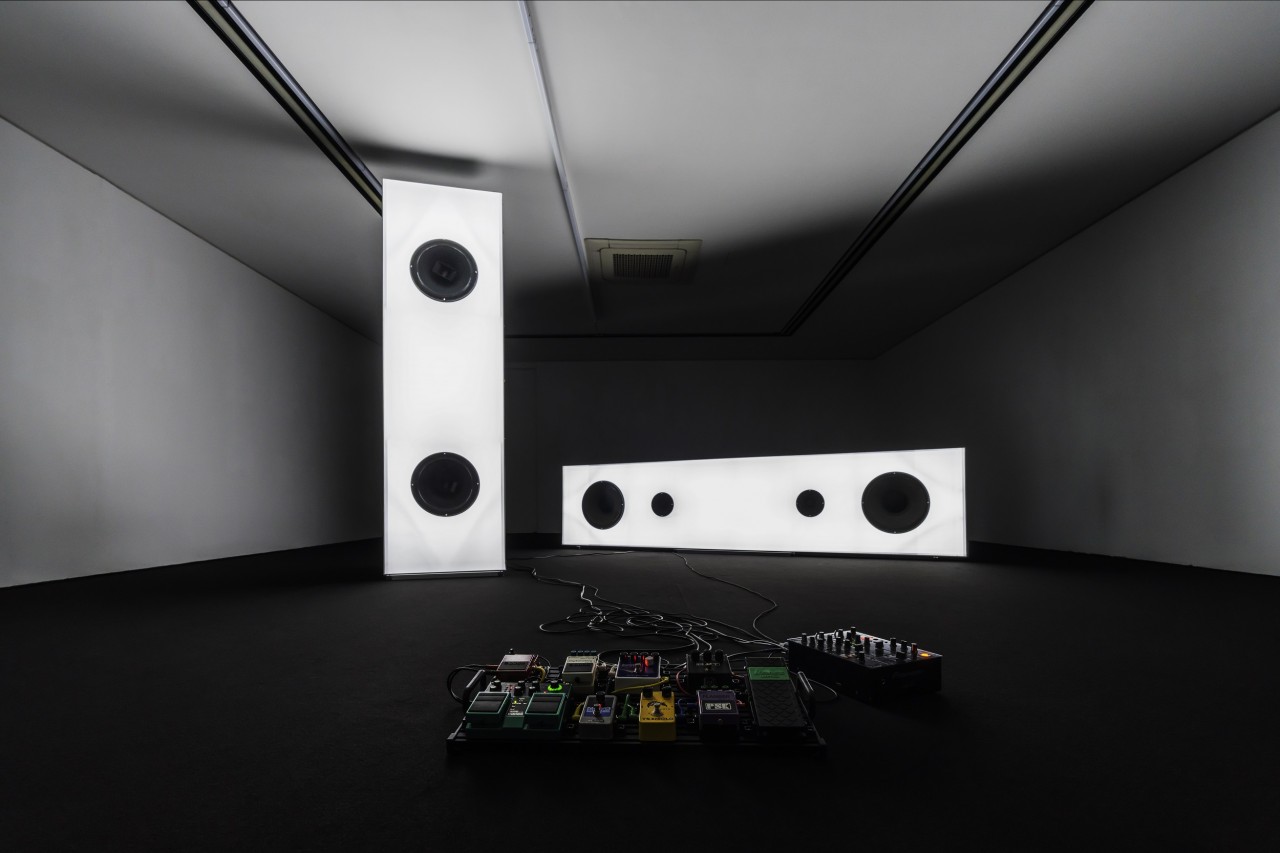 <Darkfield>, 2022. 소리 설치, 혼합매체 ; 스마트폰, 모터, 컨트롤러, 간판 프레임, LED 라이트, 스피커, PA 오디오 시스템, 기타 이펙터, 오디오 믹서, 가변크기. 사진: 조준용.
<Darkfield>, 2022. 소리 설치, 혼합매체 ; 스마트폰, 모터, 컨트롤러, 간판 프레임, LED 라이트, 스피커, PA 오디오 시스템, 기타 이펙터, 오디오 믹서, 가변크기. 사진: 조준용.
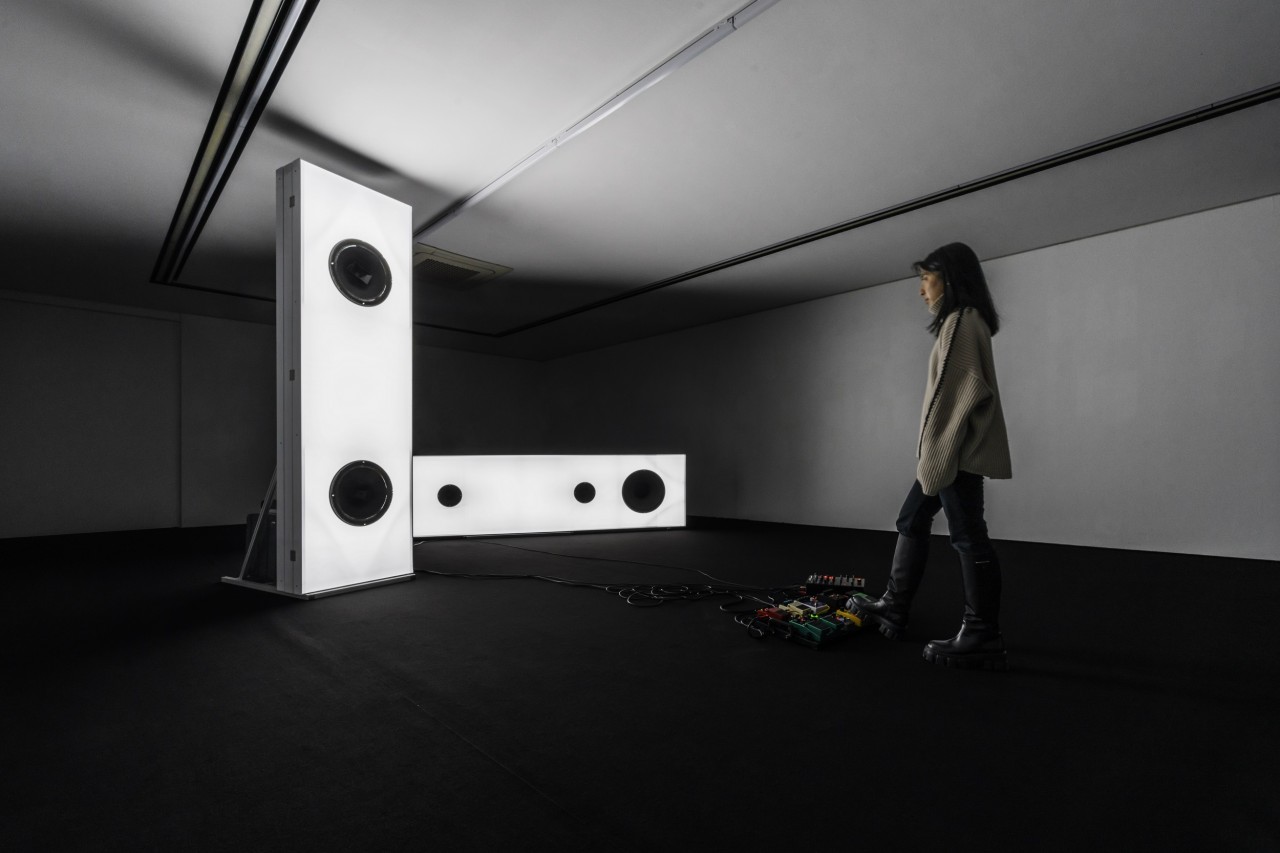 <Darkfield>, 2022. 소리 설치, 혼합매체 ; 스마트폰, 모터, 컨트롤러, 간판 프레임, LED 라이트, 스피커, PA 오디오 시스템, 기타 이펙터, 오디오 믹서, 가변크기. 사진: 조준용.
<Darkfield>, 2022. 소리 설치, 혼합매체 ; 스마트폰, 모터, 컨트롤러, 간판 프레임, LED 라이트, 스피커, PA 오디오 시스템, 기타 이펙터, 오디오 믹서, 가변크기. 사진: 조준용.
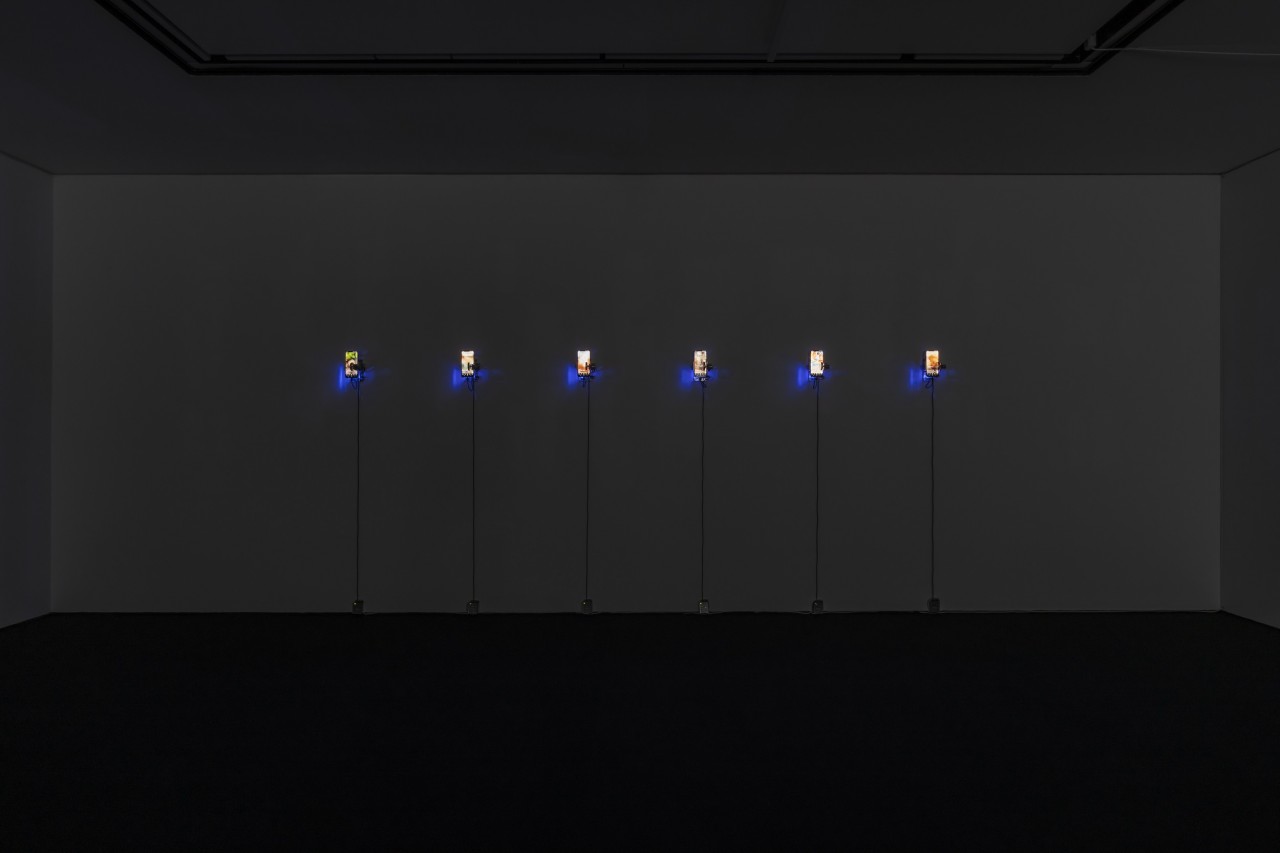 <Darkfield>, 2022. 소리 설치, 혼합매체 ; 스마트폰, 모터, 컨트롤러, 간판 프레임, LED 라이트, 스피커, PA 오디오 시스템, 기타 이펙터, 오디오 믹서, 가변크기. 사진: 조준용.
<Darkfield>, 2022. 소리 설치, 혼합매체 ; 스마트폰, 모터, 컨트롤러, 간판 프레임, LED 라이트, 스피커, PA 오디오 시스템, 기타 이펙터, 오디오 믹서, 가변크기. 사진: 조준용.



